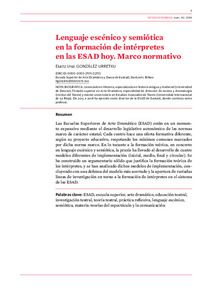Lenguaje escénico y semiótica en la formación de intérpretes en las ESAD hoy. Marco normativo

Metadata
Show full item record
Estudis escènics: quaderns de l'Institut del Teatre. 2018, Núm. 43
Document typeArticle
Abstract
Las Escuelas Superiores de Arte Dramático (ESAD) están en un momento expansivo mediante el desarrollo legislativo autonómico de las normas marco de carácter estatal. Cada centro hace una oferta formativa diferente, según su proyecto educativo, respetando los mínimos comunes marcados por dicha norma marco. En lo tocante a la formación teórica, en concreto en lenguaje escénico y semiótica, la praxis ha llevado al desarrollo de cuatro modelos diferentes de implementación (inicial, medio, final y circular). Se ha construido un argumentario sólido que justifica la formación teórica de los intérpretes, y se han analizado dichos modelos de implementación, concluyendo con una defensa del modelo más acertado y la apertura de variadas líneas de investigación en torno a la formación de intérpretes en el sistema de las ESAD. The Higher Schools of Dramatic Arts (ESAD) are in a period of expansion through the autonomous community legislative development of the national framework regulations. Each centre provides a different range of training, according to its education project, respecting the common minimums established by this framework regulation. In terms of theoretical training, specifically performing language and semiotics, the praxis has resulted in the development of four different implementation models (initial, intermediate, final and circular). There are solid arguments to justify the theoretical training of actors and these implementation models have been analysed, concluding with a defence of the most appropriate model and the opening of several lines of research into the training of actors in the ESAD system. Las Escuelas Superiores de Arte Dramático (ESAD) están en un momento expansivo mediante el desarrollo legislativo autonómico de las normas marco de carácter estatal. Cada centro hace una oferta formativa diferente, según su proyecto educativo, respetando los mínimos comunes marcados por dicha norma marco. En lo tocante a la formación teórica, en concreto en lenguaje escénico y semiótica, la praxis ha llevado al desarrollo de cuatro modelos diferentes de implementación (inicial, medio, final y circular). Se ha construido un argumentario sólido que justifica la formación teórica de los intérpretes, y se han analizado dichos modelos de implementación, concluyendo con una defensa del modelo más acertado y la apertura de variadas líneas de investigación en torno a la formación de intérpretes en el sistema de las ESAD.
Access conditionsOpen Access
ISSN2385-362X
,
0212-3819
Collections
- 2018: Núm.: 43 [15]

